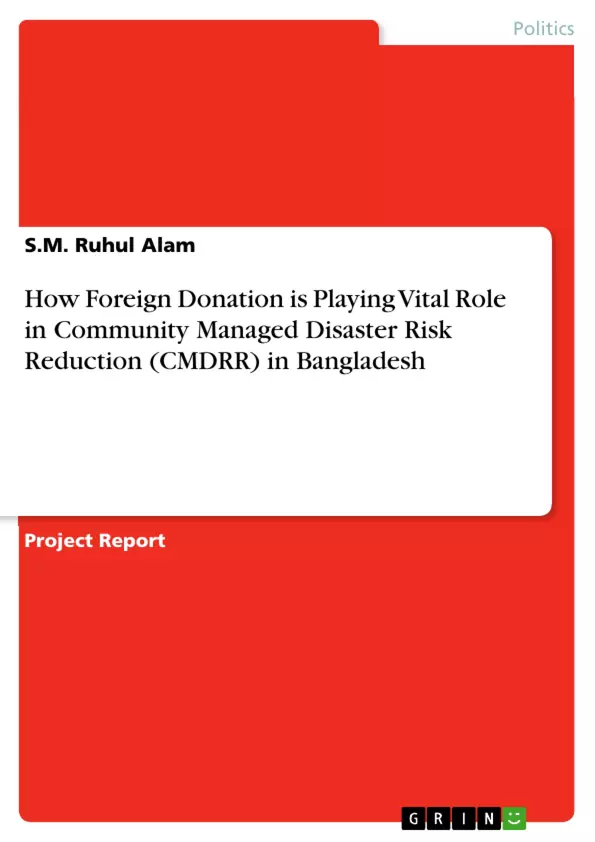River erosion is a common scenario of INDAB CMDRR working area at Babugonj upazila of Barisal district. The community people of INDAB CMDRR project area at Babugonj are most at risk to river erosion. Due to geographical location of the area a lot of people becoming landless and extreme poor every year. Particularly, the sufferings of the people of Dehergoti Union under this upazila are worse. While the Govt. initiatives are not well enough to mitigate the river erosion the community people of this area became successful in this work by using their indigenous knowledge/practice.
Using local resources (bamboo, rope, bricks and iron spike) they made bamboo cages and throw those into the river. These cages make the river wave weaker which decrease river erosion in a satisfactory rate.
Inhaltsverzeichnis (Table of Contents)
- Basic data
- Project context
- Project area table
- Overall objective
- Specific objective
- Activities at a glance performed during the period
- Report on Activities for the Period
- Outcome
- Organization (Development & change in the organization)
- Capacity Enhancement
- Forecast
- Conclusion
- Case study
Zielsetzung und Themenschwerpunkte (Objectives and Key Themes)
This report explores the vital role foreign donations play in Community Managed Disaster Risk Reduction (CMDRR) initiatives in Bangladesh, specifically focusing on the implementation of a CMDRR project in the Babuganj Upazilla of the Barisal district. The report aims to highlight the project's impact on disaster preparedness, community empowerment, and overall socio-economic development in the region.
- The impact of foreign donations on disaster risk reduction in Bangladesh.
- The role of community participation in disaster management.
- The effectiveness of CMDRR initiatives in reducing vulnerability and improving resilience.
- The challenges and opportunities associated with implementing CMDRR projects in Bangladesh.
- The long-term sustainability of community-led disaster risk reduction efforts.
Zusammenfassung der Kapitel (Chapter Summaries)
- Basic Data: This chapter provides essential information about the project, including its title, number, implementing organization, key personnel, starting date, reporting period, and status.
- Project Context: This chapter sets the stage for the report by providing background information on the geographic location of the project and the challenges posed by natural disasters in the Babuganj Upazilla. It highlights the vulnerability of the region to floods, river erosion, and cyclones, and the need for effective disaster mitigation measures.
- Overall Objective and Specific Objectives: This chapter outlines the overall goal and specific objectives of the CMDRR project. It emphasizes the project's focus on reducing disaster risk, empowering communities, and fostering long-term sustainability.
- Activities at a Glance: This chapter provides a brief overview of the key activities undertaken during the project period, emphasizing the community's involvement in every aspect.
- Report on Activities for the Period: This chapter delves deeper into the details of the various project activities, providing a comprehensive account of their implementation and impact.
- Outcome: This chapter analyzes the achievements and results of the CMDRR project, showcasing the positive impact on the community's disaster preparedness, resilience, and overall well-being.
- Organization (Development & change in the organization): This chapter focuses on the development of the implementing organization, INDAB, and its capacity to effectively deliver CMDRR programs.
- Forecast: This chapter provides a forward-looking perspective on the project's future sustainability and potential for expansion, highlighting the long-term benefits of community-led disaster risk reduction.
Schlüsselwörter (Keywords)
The report explores key concepts such as Community Managed Disaster Risk Reduction (CMDRR), foreign donation, disaster preparedness, community participation, vulnerability reduction, resilience building, and socio-economic development in the context of Bangladesh.
- Quote paper
- S.M. Ruhul Alam (Author), 2013, How Foreign Donation is Playing Vital Role in Community Managed Disaster Risk Reduction (CMDRR) in Bangladesh, Munich, GRIN Verlag, https://www.grin.com/document/265284



